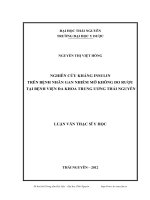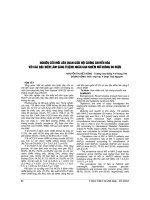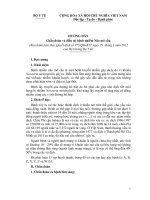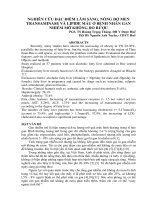CHẨN đoán và điều TRỊ GAN NHIỄM mỡ KHÔNG DO rượu
Bạn đang xem bản rút gọn của tài liệu. Xem và tải ngay bản đầy đủ của tài liệu tại đây (1.72 MB, 50 trang )
HỘI NGHỊ NỘI KHOA MIỀN TRUNG MỞ RỘNG 2015
CẬP NHẬT CHẨN ĐOÁN VÀ ĐIỀU TRỊ
GAN NHIỄM MỠ KHÔNG DO RƯỢU
Non alcoholic fatty liver disease
Diagnosis and management
GS.TS HOÀNG TRỌNG THẢNG
Đại học Y Dược Huế
obesity
Environment
Dietary factors
Food intake
Physical activity
Gut microflora
Insulin resistance
NAFLD
Genetic
Oxidative stress
Immune related
Metabolic
hyperlipidemia
inflammation
BỆNH NGUYÊN VÀ BỆNH SINH CỦA NAFLD
VAI TRÒ VIÊM- MIỄN DỊCH
TRONG NASH
LÝ THUYẾT HIỆN NAY
Tilg và Moschen: 'multiple parallel hits’
• Viêm là hậu quả nhiều cái HIT đồng hành.
• Có nguồn gốc từ mô mỡ nội tạng/ các
cytokine của VK ruột, Adipokine mang tín
hiệu lưới nội võng.
• Gây kích thích và khởi phát miễn dịch là
yếu tố chính trong bệnh sinh của NASH.
Tế bào gan:
TẾ BÀO KUPFFER (KCs)
• Phóng thích các cytokines tiền viêm: IL-1,
IL-6, and TNFɑ
• Thúc đẩy thâm nhiễm các TB viêm đa
nhân để loại bỏ VK.
• KCs cũng sản xuất IL-12, IL-18 hoạt hóa
NK cells để sản xuất anti-viral IFN γ.
• Sau khởi phát hoạt hóa các proinflammatory cytokines, KCs phóng thích
IL-10 làm điều hòa sản xuất TNFɑ , IL-6
và các cytokines khác.
TẾ BÀO SAO: stellate cells (HSCs)
• HSCs, được mô tả nhiều trong xơ hóa
gan.
• Chúng có khả năng trình diện KN lipid cho
các TB T hạn chế CD1d, đó là các TB
NKT.
• Nó cũng có khả năng trình diện kháng
nguyên cho CD4+ or CD8+ T cells
CHẨN ĐOÁN NAFLD
• NAFLD cần loại trừ
-Viêm gan rượu
-Viêm gan do thuốc (tamoxifen, amiodarone)
-Viêm gan virus
-Viêm gan tự miễn
-Gan Chuyển hóa (Wilson, Hemochromatosis)
Xét nghiệm thăm dò
• ~ 80% ca trong giới hạn thường
• Hiện nay chưa có XN nào đặc hiệu cho
NAFLD
• Aminotransferase tăng (< 4 times ULN)
• AST/ALT (AAR) > 1 gợi ý xơ gan
• AST, ALT cao và AAR thường phối hợp với
NASH
• Kiểu tăng của aminotrasferase không giúp
phân biệt FLD và NASH.
HÌNH ẢNH
Siêu âm
- XN đầu tay
- Nhu mô gan tăng âm (gan sáng)
- Hút âm sau gan
- Độ đặc hiệu cao (~ 90%)
• Siêu âm đối quang:
- Dùng các vi bọt để tăng cường đối
quang khi qua tĩnh mạch gan.
- Trong NASH giảm tăng cường tín hiệu
so với trong GNM đơn thuần do TB tổn
thương giảm bắt giữ levovist.
CT Scan
Normal appearance
of the liver at unenhanced
CT. The attenuation of the
liver (66 HU) is slightly
higher than that of the
spleen (56 HU), and
intrahepatic vessels (v)
appear hypoattenuated in
Comparison with the liver.
Normal appearance of the liver
Diffuse fat accumulation in the liver at unenhanced CT.
The attenuation of the liver (15 HU) is
markedly lower than that of the spleen (40 HU).
Intrahepatic
vessels (v) also appear hyperattenuated in comparison
with the liver.
Fatty liver on CT Scan
MRI
Normal appearance of the liver at MR imaging. Axial
opposed-phase (a) and axial in-phase (b) T1- weighted GRE
images
show similar signal intensity of the liver parenchyma.
Diffuse fat accumulation in the liver at MR imaging.
Axial T1-weighted GRE images show a marked
decrease in the signal intensity of the liver on the opposed
phase image (a), compared with that on the in-phase
image (b).
PET Scan
Regions of interest were placed on liver (large circles) and
spleen (small circles) as well as on mediastinum
(not shown) on both CT (left) and PET (right) to calculate CT
attenuation values and standardized uptake values,
respectively. In this case, mean hepatic attenuation was −13
HU and mean splenic attenuation was 62 HU.
Sinh thiết gan
Tiêu chuẩn vàng trong chẩn đoán và tiên lượng
Không cần làm khi bệnh điển hình
Chỉ định khi:
- High ferritin with HFE mutations
- Positive autoantibodies
- The use of medications associated with drug induced
liver injury
- Accurate staging of disease in patients with several risk
factors
Hạn chế:
• Thăm dò xâm nhập
• Nguy cơ gây BC
• Mẫu ST không đúng chổ
• Khác biệt giữa người đọc
Chất chỉ điểm sinh học trong
steatohepatitis and fibrosis
•
•
•
•
•
•
•
•
•
•
•
CRP: independent risk factor for the progression of NAFLD
Plasma Pentraxin 3: risk factor for the progression of NAFLD
IL6: indicate inflammmatory activity and the degree of fibrosis
TNF α: risk factor for the progression of NAFLD
Cytokeratin 18: marker of hepatic appoptosis
Polypeptide specific antigen: released during appoptosis
Endothelin 1: is a mediator of fibrosis
Oxidative stress biomarkers: superoxide desmutase, glutathione
peroxidase, Thioredoxin
Hyaluronic acid
Type 4 collagen
Laminin
Panel of markers/Scoring systems
•
•
•
Identification of steatosis
“NAFLD liver fat score” includes:
- Presence of DM
- Fasting serum insulin
- AST
- AST/ALT ratio
“Fatty liver index” includes:
- BMI
- Waist circumference
- Triglyceride
- GGT
“Visceral adiposity index” includes:
- BMI
- Waist circumference
- Triglyceride
- HDL









